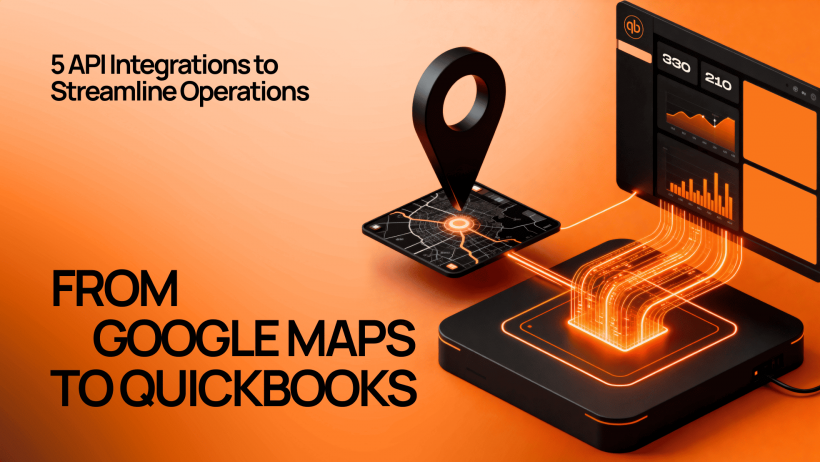The power of API integration services for business efficiency
Modern API integration tools and Best API integration software help connect once‑isolated platforms into one synchronized system, turning websites, CRMs, payment gateways, accounting ledgers, logistics platforms, and e‑signature apps into a single reliable ecosystem. Instead of manual imports or broken spreadsheets, data moves in real time and triggers meaningful actions that teams can trust. This reduces swivel‑chair work, improves cycle time, and makes your processes repeatable when the team grows or when demand spikes. With Custom API integration services, leaders gain visibility, and employees get simpler, faster workflows that let them focus on meaningful work instead of repetitive entry.
When you standardize how systems communicate, small issues stop multiplying and big problems become visible earlier. Orders no longer stall because an address was mistyped in one system, and invoices don’t disappear before month‑end. Security and governance improve because you can centralize access, rotate tokens, and audit events across services following API security best practices. For small businesses, the right stack balances power and Affordable API integration pricing. For large enterprises, it becomes the backbone that supports scalability, resilience, and consistent customer experience.

Google Maps API integration for smarter logistics
Integrating the Google Maps routing API transforms logistics into a continuously updated map of real‑world operations rather than static plans. Dispatchers calculate realistic ETAs, fix addresses automatically, and design routes that respect traffic, time windows, and service priorities. Couriers follow turn‑by‑turn navigation and share live location data, cutting down on calls and status checks. Customers receive precise notifications and predictable delivery windows aligned with road conditions.
When connected as a Real‑time logistics API to CRM, inventory, and notification systems, a confirmed order automatically creates a route stop, a failed delivery triggers a follow‑up message, and a completed job updates inventory and billing instantly. This automation reduces fuel consumption, improves on‑time performance, and highlights bottlenecks you can fix. Over time, data lets you simulate route changes, balance fleet capacity, and choose better pickup points, producing fewer delays and a friendlier customer experience.
QuickBooks API connector for seamless accounting
QuickBooks integration removes manual retyping through QuickBooks automated bookkeeping. Orders that close in your storefront or CRM instantly generate invoices, and cleared payments update the books automatically. Taxes, fees, and credits follow consistent rules, keeping profit and loss accurate all month. Every transaction is traceable back to its customer and order for instant context. With a concise QuickBooks API setup guide, you can implement best practices in hours instead of days.
Linking QuickBooks to your payment gateways and shipping platforms ensures that revenue and costs move together into the right accounts. Controllers and owners gain timely visibility, smooth reconciliation, and accurate forecasting. Small businesses benefit most: they save entire days of manual work while preserving control through audit logs, role‑based permissions, and predictable workflows. Combined with Custom API integration services, QuickBooks becomes the nerve center for clean data and confident decisions.
Stripe and PayPal integrations for secure, flexible payments
The Stripe API payment gateway and PayPal developer API integration deliver enterprise‑grade payment capabilities without complex development. Tokenized card data, 3D Secure, and AI‑driven fraud detection ensure safety while maintaining a seamless checkout. Immediate payment confirmations sync with accounting, inventory, and analytics tools, keeping the full purchase lifecycle synchronized. Multi‑currency API payments enable international buyers to pay in their local currencies with transparent exchange rates.
Saved tokens simplify repeat purchases, automated refunds shorten queues, and standardized dispute APIs streamline evidence collection. When these systems operate inside one fabric—your storefront, accounting, and CRM—they create full revenue transparency and reduce human error. Businesses can segment customers, track campaign impact, and detect anomalies early. Together, these APIs offer flexibility, security, and insight without rebuilding your financial infrastructure.
DocuSign API for digital agreements that move faster
DocuSign API workflow automation and Electronic signature API solutions eliminate paper chases and fragmented attachments. Sales teams send agreements directly from the CRM, customers sign securely from any device, and signed copies are automatically stored in the correct folder. Roles, reminders, and expirations are embedded in the workflow, ensuring compliance and continuity. Legal and operations teams gain traceability, version control, and a complete activity trail without micromanaging each step.
Security is built in: time stamps, hashes, and encrypted storage guard every signature. Permissions and SSO provide access control, ensuring that contracts, invoices, and receipts form a tamper‑evident record. Together with accounting and payments, this integration creates an auditable chain of trust—faster deals, fewer disputes, and a smoother experience for both teams and clients.
Best practices for implementing API integrations

Effective integrations start with mapping the business process, defining a minimal but reliable data contract, and rolling out in small, observable steps. Focus on high‑impact events like order creation, payment capture, or delivery confirmation. Specify critical fields and design automated recovery for predictable errors. Choose SDKs with strong documentation, clear SLAs, and transparent rate limits. Always design for resilience with retries, idempotency keys, and queue systems that follow API security best practices.
- Identify key events that must always be accurate and real time.
- Adopt SDKs with predictable limits and stable performance.
- Deploy in phases: stabilize core flows first, then expand.
- Design for failure and automatic recovery mechanisms.
- Rotate credentials and review permissions regularly.
Emerging trends in business API integration
AI‑assisted integration platforms can now suggest field mappings, detect missing handlers, and predict failures before they occur. Predictive analytics can also advise dispatchers to adjust Google Maps routing API schedules or payments teams to retry transactions intelligently. As standardization grows, connecting a new service feels like snapping a new module into a labeled slot instead of starting from scratch.
Operational discipline—monitoring, change management, and post‑incident reviews—is becoming standard. When your accounting, logistics, and payment APIs share consistent hygiene, you spend less time firefighting. And if internal capacity is limited, you can Hire API integration developer professionals for targeted automation projects that deliver results quickly without overwhelming your teams.

FAQ: API Integration Services
How do API integration services reduce manual work without breaking existing processes?
They replace brittle handoffs with event-driven updates that keep systems synchronized automatically, reducing retyping and follow-up errors. Because a single event updates multiple tools simultaneously, your team trusts one source of truth while retaining control where needed. Over time, this consistency improves data quality, cycle times, and overall reliability.
What advantages does a QuickBooks API connector offer to a small or midsize business?
It automates invoice generation, payment posting, refunds, and tax logic so accounting reflects real-time results rather than delayed summaries. Managers gain cash-flow visibility, while staff avoid duplicate entry and inconsistent data. Every record connects directly to the customer and order, simplifying audits and allowing quick drill-downs. Standardized categorization ensures reports remain comparable as you scale.
Which industries benefit most from Google Maps API integration and why?
Any industry reliant on scheduling or geography—delivery, field service, retail pickup, healthcare, or construction—benefits from the Google Maps routing API. Accurate ETAs cut inbound “where’s my order” calls, optimized routes save fuel, and predictive mapping allows better resource allocation. When this data feeds inventory and CRM, operations can proactively balance capacity and improve reliability.
Are Stripe and PayPal safe enough for online payment API integration at scale?
Yes. Both providers offer robust tokenization, encryption, and compliance frameworks. Fraud detection and multi-currency API payments make them ideal for global operations. APIs provide consistent webhooks and refund mechanisms that ensure transaction accuracy and traceability. Combined with internal access control and auditing, they deliver scalable, secure payment processing.
What real-world advantages come from integrating DocuSign instead of sending PDFs by email?
API-based electronic signature solutions provide faster cycle times, fewer lost documents, and a tamper-evident record. Customers can sign via mobile devices, and teams can send, track, and archive contracts automatically. Automated reminders and expirations reduce missed deadlines and manual chasing. Integration with CRM and accounting closes the loop from proposal to payment in one workflow.
Do integrations require ongoing maintenance, and how should businesses plan for it?
Yes, and the workload is manageable when treated as a continuous product. Plan for secret rotation, certificate renewal, API version updates, and monitoring rate limits. Dashboards showing lag, retries, and error rates keep teams proactive. Outsourcing periodic reviews to a Hire API integration developer partner ensures long-term reliability.
How can businesses ensure API integrations remain cost-effective over time?
By reviewing usage patterns, consolidating redundant connections, and leveraging affordable API integration pricing tiers. Focus on core automations that deliver measurable ROI—order syncs, payment flows, or document handling. As efficiency improves, savings from reduced manual labor often exceed integration costs within months.
What’s the difference between generic connectors and custom API integration services?
Generic connectors handle simple data syncs but often lack flexibility. Custom API integration services tailor logic, mapping, and triggers to fit unique business processes. They ensure deeper reliability and performance when standard tools fall short, especially in complex ecosystems like logistics or finance.
When should a company consider hiring a developer or consultant?
When scaling, integrating multiple providers, or adding compliance layers, you can hire API integration developer experts. They build optimized pipelines, implement API security best practices, and document systems for maintainability. This short-term investment pays long-term dividends in uptime and data consistency.

